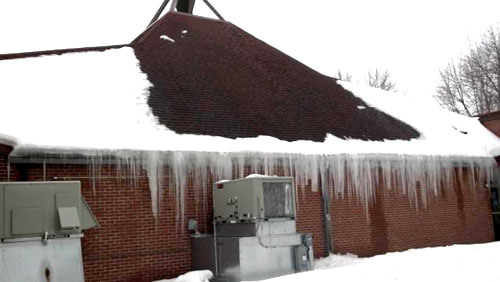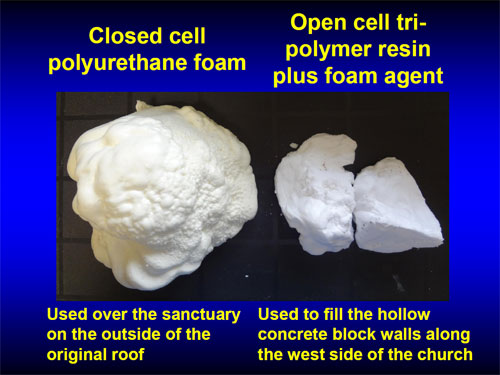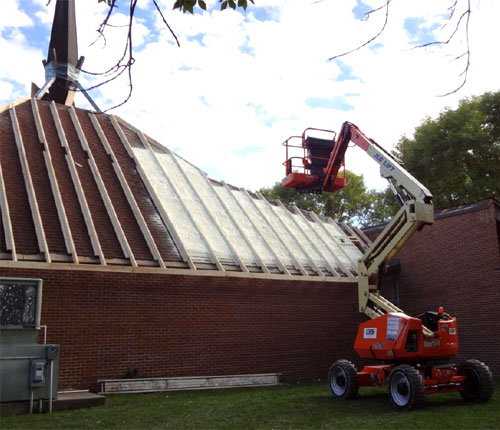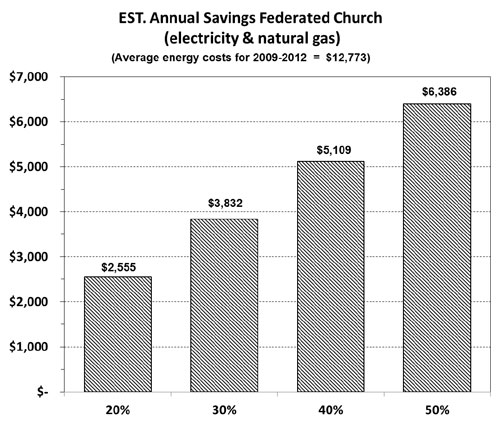Have you ever seen the “icicle show” at the Federated Church in Morris, Minnesota? The icicles occurred following roof snowmelt and subsequent freezing and grew to be as long as 6 feet hanging from the edge of the roof (see picture). Some of these icicles were massive and if they broke off and hit you, it could’ve been a disaster.
Well, the icicles are gone for good. The icicles were the visible symbol of a major heat loss problem that has plagued the church for the last 42 years. The structure was showing physical damage and interior water spots resulting from heat loss caused by the complex roof lines of the church, the lack of ventilation, and poorly or non-insulated thermal boundaries. The architect apparently was not familiar with West Central Minnesota winters, and engineering design and construction did not allow for simple addition of ceiling insulation and ventilation without removing or modifying the roof. Energy costs were literally through the roof and yes, we literally had real bats in our metaphorical belfry! The challenge was how do we address this enormous energy conservation problem and also routine maintenance and repair?

The winter icicle show on the Federated Church.
It isn’t easy being “green”. Opportunity knocked as a result of a hailstorm in 2012 (15 August 2012), the Federated Church filed an insurance claim to replace the damaged shingles. A contractor, JNS Builders, came to bid on the roof repair project indicated that we had a major problem with potential structure degradation as a result of poor insulation and ventilation and they suggested the church contact RetroGreenEnergy, an insulation and energy auditing company, to explore further options for energy conservation and to gain efficiencies by completing the shingle replacement and insulation/ventilation installation as part of a coordinated project.
An “eye opening” PowerPoint presentation by RetroGreenEnergy to a small group of church members on 9 July, 2013, vividly described the magnitude of the problem and damage already evident. Significant damage occurred as a result of no ventilation and no insulation in various sections of the church roof was reinforced by an energy audit. We had a “mini mushroom farm” of fungus and mold growing in one section under the roof. Other ventilation and insulation problems in the concrete walls were also identified. The contactor stated that some parts of the church roof had no insulation at all, only 3 inches of wood supporting the shingles and estimated an average R-value of about 6 for the entire roof and the outer concrete block walls when the desired roof R-value is 50. The small amount of insulation included during the initial construction of the church, plus small amounts of additional insulation blown in when the roof line was modified were not enough to provide significant energy savings due to leakage at critical locations and the lack of controlled ventilation.

Foam insulation used in the project.
The insulation and vent materials included two types of foam insulation (open cell foam in the concrete walls and closed cell foam on the roof), blown in bat insulation, 162 vents installed, over 2000 feet of cracks caulked, and all associated labor. The complex roof has a “steep pyramid shape” over the main sanctuary that required additional safety equipment for the workers. The remaining parts of the church had more conventional type roofing. A justification and request for financial support was prepared. We applied for grants and zero interest loans from several private, state and federal agencies. Otter Tail Power Company provided a grant, CenterPoint energy provided a rebate, the Center for Energy and Environment (CEE) provided a grant and a zero-interest loan, the Federated Church Shepherd fund provided a grant, and a small portion came from the balance of the hail damage insurance claim. Many of the building materials were purchased through Hooters Lumber in Chokio.
Plans were made and schedules coordinated for the two contractors and work began on September 23, 2013. The church roof was completely sealed the night before the 0.2 in. rain on Friday, September 27, thanks to the crew working overtime, and the remaining work was completed in between the occasional showers with both contractors leaving the site on Friday October 4, 2013.

Insulating the roof from the outside.
Before leaving the site, RetroGreenEnergy did a “leak test” measurement and determine the leakage rate was 58% lower than that measured at the start of the project, a major improvement! The combination of the decrease in “leakage rate” and the increased insulation across the entire roof of the church will contribute to substantial energy and cost savings, estimated to be as high as 50% by the contractor. The insulation R-value for the area over the sanctuary that was sprayed with 3 inches of foam ended up with an R-value of 28 and the remainder of the church roof had an R-value of 50.
The real “green” savings will require four years to collect sufficient data to make an accurate “before and after” assessment. We have ESTIMATED the potential savings based on actual cost for the four-year period from 2009 through 2012. Using the average utility costs of $12,773 for those four years, we then calculated ASSUMED annual cost savings at 20, 30, 40, and 50% reduction in energy costs with the results shown in figure the figure below. A 20% energy savings, the cost savings is $2554 and at 50% energy savings, the cost savings is $6683 per year with a corresponding decrease in the carbon footprint. Using these cost savings and accounting for inflation, we have blown a lot of heat through the roof and more $310,000 over the last 42 years.
We at the Federated Church are doing our small part to be “green” which implies more sustainable and environmentally responsible. The key message is that a small amount invested in proper insulation at the time of construction provides energy and cost savings that multiply with time. It’s something to think about if you are cost and energy conscious. What are you doing to reduce your energy costs and carbon footprint?

Estimated cost savings based on assumed energy reductions for the four-year average from 2009-2012.
Check out more photos in this step-by-step presentation!
As you’ve learned, the Federated Church in Morris, MN was known for their winter icicle show, due to a lack of insulation that allowed heat to be lost through the roof. This presentation takes you step by step through their efforts to tighten up the building for energy and cost savings.
 |
The Get Answers series on the Energy Stories Blog offers useful tips from CERTs and our partners to help you get to the bottom of your energy efficiency and renewable energy questions. Click here to see more stories in the series >> |


